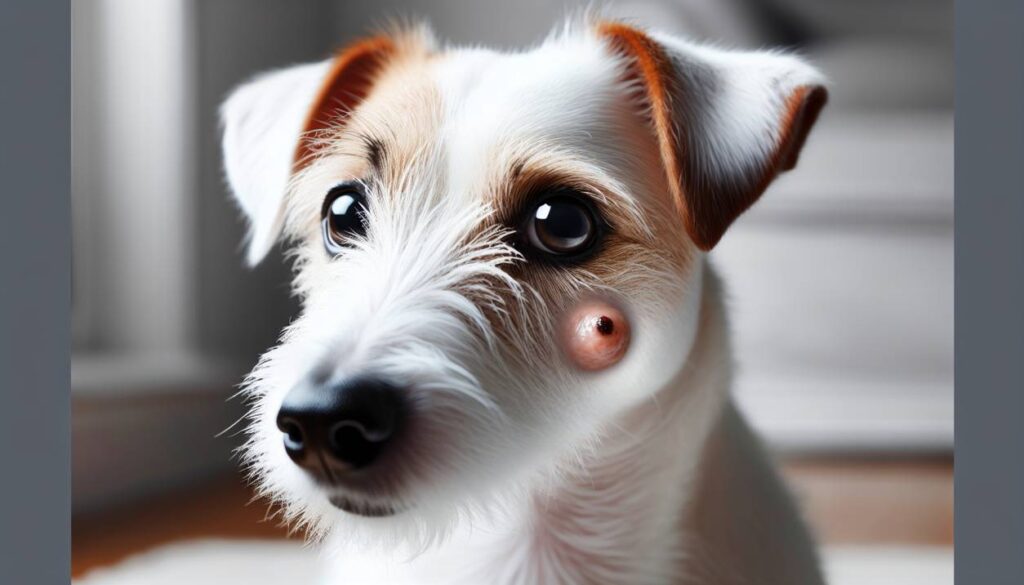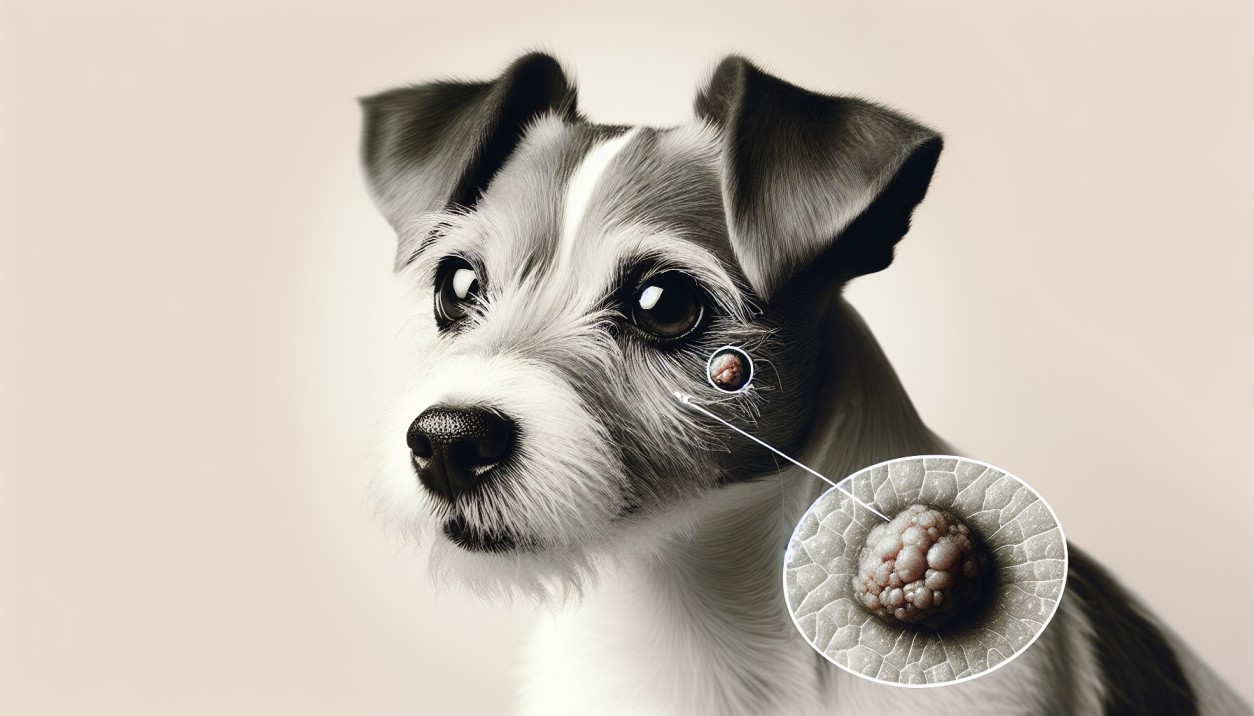Understanding Lumps on Jack Russells
Have you ever noticed a strange lump on your beloved Jack Russell? Don’t panic, as lumps can be quite common in this breed. In this article, we will help you better understand the various causes of lumps on Jack Russells, providing you with valuable insights to ease your concerns. Whether it’s a harmless fatty lump or something more serious, we’ll guide you on when to seek veterinary advice and how to ensure the well-being of your furry companion.
So, let’s uncover the mysteries behind these lumps and equip you with the knowledge you need to make informed decisions for your Jack Russell’s health.
Causes of Lumps on Jack Russells
Lipomas
Lipomas are one of the most common causes of lumps on Jack Russells. These are benign fatty tumors that can develop under the skin. Lipomas usually feel soft and movable, and they often appear in middle-aged to older dogs. While they are generally harmless, large or rapidly growing lipomas may need to be surgically removed.
Cysts
Cysts are another common cause of lumps on Jack Russells. These are fluid-filled sacs that can form on the skin or beneath it. Cysts can vary in size and may feel firm or squishy to the touch. They can be caused by blocked hair follicles, infections, or trauma. While most cysts are benign, they can become infected or cause discomfort if they grow too large. In such cases, drainage or surgical removal may be necessary.
Abscesses
Abscesses are painful, swollen lumps that are filled with pus. They often occur as a result of a bacterial infection, which can develop from a puncture wound or an underlying skin condition. Abscesses can cause redness, warmth, and tenderness in the affected area. Treatment typically involves draining the abscess, cleaning the wound, and prescribing antibiotics to fight the infection.
Skin Infections
Various types of bacterial, fungal, or yeast infections can cause lumps or growths on the skin of Jack Russells. These infections can lead to redness, swelling, and itching. The lumps may be filled with pus or discharge, and the surrounding skin may appear inflamed or irritated. Treatment for skin infections typically involves topical or oral medications, depending on the severity of the infection.
Allergies
Allergies, whether they are caused by food, environmental factors, or fleas, can also contribute to the development of lumps on Jack Russells. Allergic reactions can cause the skin to become itchy, irritated, and inflamed. Dogs may scratch or bite at the affected areas, leading to the formation of sores or hot spots. Identifying and managing the underlying allergy is crucial in preventing the recurrence of lumps.
Skin Tumors
While less common than benign lumps, malignant skin tumors can also occur in Jack Russells. These tumors can range from slow-growing to aggressive and may require immediate veterinary attention. Skin tumors can appear as firm, raised growths or ulcers. If you notice any suspicious lumps on your dog’s skin, it is important to have them evaluated by a veterinarian as early detection can increase the chances of successful treatment.
Flea Bites
Flea bites are a common cause of lumps and skin irritation in dogs, including Jack Russells. These tiny, wingless insects can cause an allergic reaction in some dogs, leading to intense itching and the development of small, red bumps. Preventing fleas through regular use of flea preventive medications and promptly treating any infestations can help minimize the risk of flea-induced lumps.
Hematomas
Hematomas are lumps caused by the accumulation of blood beneath the skin. They commonly occur as a result of trauma or injury, such as vigorous scratching or biting. Hematomas may appear as soft, fluid-filled swellings that can be warm and painful to the touch. Treatment may involve draining the hematoma and addressing the underlying cause.
Ingrown Hairs
Ingrown hairs can sometimes lead to the formation of lumps on a dog’s skin. When a hair follicle becomes clogged or blocked, the hair can grow sideways or downward instead of upward, causing inflammation and the development of a small lump. Treating ingrown hairs often involves gently extracting the hair and keeping the area clean to prevent infection.
Bacterial Infections
Bacterial infections, such as pyoderma, can cause lumps or pustules to form on the skin of Jack Russells. These infections are often the result of an underlying issue, such as allergies or hormonal imbalances, which create an environment conducive to bacterial overgrowth. Treatment typically involves antibiotics and addressing the underlying cause to prevent recurrent infections.
Signs and Symptoms of Lumps on Jack Russells

Swelling
One of the most prominent signs of lumps on Jack Russells is swelling in the affected area. The lump may be visibly larger than the surrounding tissue or cause a noticeable bulge under the skin.
Redness
Inflamed lumps can cause the skin around them to become red and irritated. The intensity of the redness can vary depending on the underlying cause and the dog’s individual response.
Pain or Discomfort
Lumps on Jack Russells can sometimes cause pain or discomfort, especially if they are infected, abscessed, or located in a sensitive area. Dogs may show signs of discomfort like vocalization or limping.
Itching
Itching is a common symptom associated with many causes of lumps on Jack Russells, particularly those related to allergies or parasites. Dogs may constantly scratch, lick, or chew at the affected area, leading to further irritation or secondary infection.
Changes in the Lump’s Size or Shape
Monitoring the size and shape of the lump is essential in determining its progress or potential seriousness. Rapid growth, a sudden increase in size, or noticeable changes in shape should be closely watched and promptly evaluated by a veterinarian.
Oozing or Draining
Lumps that are infected or filled with fluid may exhibit oozing or draining. Discharge may range from clear or bloody to pus-like, and it often indicates the need for veterinary intervention.
Hair Loss
The presence of hair loss or thinning around the lump can be a sign of irritation, infection, or underlying skin conditions. The affected area may appear patchy or have broken or damaged hair follicles.
Presence of Pus or Blood
Lumps that display the presence of pus or blood may indicate an infection or a more serious underlying issue. Veterinary care is necessary to properly diagnose and treat the cause of the lump.
Difficulty in Moving or Limping
If a lump is causing pain or discomfort, it may impact a dog’s mobility. Difficulty in moving, limping, or favoring a particular leg or body part should be evaluated by a veterinarian to address the underlying cause.
Behavioral Changes
In some cases, dogs with lumps may exhibit changes in behavior, such as increased aggression, avoidance, or withdrawal. These behavioral changes may manifest as a response to pain, discomfort, or illness associated with the lump.
Diagnosing Lumps on Jack Russells
Physical Examination
During a physical examination, a veterinarian will visually inspect and palpate the lump and surrounding area. They will assess its size, shape, color, consistency, and any associated symptoms. The presence of other lumps or abnormalities may also be noted.
Fine Needle Aspiration (FNA)
Fine needle aspiration (FNA) involves using a thin needle to collect cells or fluid from the lump. These samples are then examined under a microscope to determine the nature of the lump, whether it’s benign or malignant, or if further testing is required.
Biopsy
Sometimes, if the lump’s nature cannot be determined through FNA or if a more accurate diagnosis is needed, a veterinarian may recommend a biopsy. A small piece of tissue is surgically removed from the lump and sent to a laboratory for microscopic examination.
Blood Tests
Blood tests may be conducted to evaluate a dog’s overall health and to detect any underlying conditions that may contribute to the development of lumps, such as infections or hormonal imbalances.
Imaging Techniques
In cases where the lump is suspected to be deep-seated or involve underlying structures, imaging techniques such as X-rays, ultrasounds, or CT scans may be utilized. These imaging modalities help assess the extent and location of the lump, aiding in diagnosis and treatment planning.
Cytology
Cytology involves examining cells from the lump under a microscope to identify any abnormal cell growth or structures. It is particularly useful in diagnosing infections, inflammation, or benign growths.
Allergy Testing
If allergies are suspected as the underlying cause of the lump, allergy testing may be recommended. This can involve blood tests or skin patch tests to identify specific allergens triggering the allergic reaction.
Microscopic Examination
Microscopic examination of the lump’s tissue or cells can provide a more detailed analysis and help determine the proper course of treatment. It can reveal whether the lump is benign, malignant, or associated with inflammation or infection.
Skin Scraping
Skin scraping involves gently scraping the surface of the skin to collect samples for microscopic examination. This is particularly useful in diagnosing skin infections caused by external parasites such as mites or fleas.
Culture and Sensitivity Testing
If a bacterial infection is suspected, a culture and sensitivity test may be conducted. This involves collecting a sample from the lump and growing the bacteria in a laboratory to identify the specific type and determine which antibiotics are most effective in treating it.
Treatment Options for Lumps on Jack Russells
Wait-and-Watch Approach
In some cases, especially when the lump is small, benign, and not causing any discomfort, a veterinarian may recommend monitoring the lump over time. This approach allows for observation and can help determine if further intervention is necessary.
Surgical Removal
Surgical removal is often recommended for lumps that are suspected to be malignant, growing rapidly, causing pain or discomfort, or hindering a dog’s mobility. During the procedure, the lump is excised along with a margin of surrounding healthy tissue to ensure complete removal.
Draining of Abscesses
If the lump is an abscess filled with pus, it may need to be drained. A veterinarian will make a small incision to release the pus and clean the affected area. Based on the severity of the abscess, additional treatment such as antibiotics may be prescribed.
Liposuction
In cases where the lump is a lipoma, liposuction may be a viable treatment option. This minimally invasive procedure involves vacuum-assisted removal of the fatty tumor through small incisions.
Cryosurgery
Cryosurgery involves using extreme cold to freeze and destroy abnormal tissues. It can be an option for small, superficial lumps or early-stage skin tumors.
Chemotherapy
When the lump is diagnosed as a malignant tumor or cancer, chemotherapy may be recommended. This treatment involves the use of drugs to kill or slow the growth of cancer cells. Chemotherapy may be administered orally, intravenously, or topically, depending on the specific type and location of the cancer.
Radiation Therapy
Radiation therapy utilizes high-energy rays to destroy cancer cells. It is often used in conjunction with surgery or as a standalone treatment for inoperable or recurrent tumors.
Antibiotics
If the lump is caused by a bacterial infection, antibiotics may be prescribed to eliminate the infection and reduce inflammation.
Anti-Allergy Medications
For lumps related to allergies, anti-allergy medications such as antihistamines or corticosteroids may be prescribed to manage the allergic response and alleviate symptoms.
Pain Management
In cases where the lump is causing discomfort, pain management medications or techniques may be recommended to improve the dog’s quality of life. This can include oral pain medications, topical creams, or alternative therapies like acupuncture or physical therapy.
Preventing Lumps on Jack Russells
Proper Hygiene and Grooming
Maintaining good hygiene and regular grooming practices can help prevent many skin issues that can lead to lumps. Regular bathing, brushing, and nail trimming can keep the skin clean and free from debris.
Skin Inspections
Frequent skin inspections can aid in early detection of any unusual lumps or changes in the skin. Regularly checking your Jack Russell’s skin for lumps, sores, or other abnormalities can help identify and address any concerns promptly.
Regular Vet Check-ups
Routine visits to the veterinarian are essential for overall health maintenance and early detection of any potential health issues. Regular check-ups allow the vet to assess the dog’s skin, provide necessary vaccinations, and address any concerns or questions.
Parasite Prevention
Preventing parasites, such as fleas, ticks, and mites, is crucial in avoiding skin irritation and the development of lumps. Consistently using flea and tick preventives as recommended by your veterinarian can keep parasites at bay.
Diet and Nutrition
Providing a balanced and nutritious diet is vital for a dog’s overall health, including their skin. Ensuring the diet contains appropriate proteins, fats, vitamins, and minerals can help maintain healthy skin and reduce the risk of certain skin conditions.
Avoiding Allergens
Identifying and avoiding allergens that trigger allergic reactions in your Jack Russell is crucial in preventing allergic skin conditions. This may involve dietary changes, avoiding specific environmental allergens, or using hypoallergenic grooming products.
Prompt Treatment of Injuries
Treating any cuts, wounds, or injuries promptly can help prevent infections and subsequent lump formation. Cleaning wounds with mild antiseptics and seeking veterinary care when necessary can aid in proper wound healing.
Avoiding Exposure to Carcinogens
Limiting exposure to potential carcinogens, such as tobacco smoke, certain chemicals, or excessive sun exposure, can help reduce the risk of skin tumors. Providing a safe and protected environment for your dog is essential in maintaining their overall health.
Maintaining a Healthy Weight
Obesity can contribute to various health issues, including skin problems. Maintaining a healthy weight through proper diet and regular exercise can help prevent skin conditions and promote overall well-being.
Reducing Stress Levels
Chronic stress can weaken the immune system and contribute to various health problems, including skin conditions. Providing a stress-free environment, incorporating mental and physical stimulation, and addressing any underlying anxiety can help reduce the risk of skin issues and lumps.
When to Seek Veterinary Care
Rapid Growth of the Lump
If the lump on your Jack Russell is rapidly growing in size, it is important to seek veterinary care. Rapid growth can be a sign of a more aggressive or malignant condition that needs immediate attention.
Persistent or Worsening Symptoms
If the symptoms associated with the lump persist or worsen over time, it is essential to consult with a veterinarian. These symptoms can include increased redness, swelling, pain, or discomfort.
Open or Bleeding Sores
Lumps that develop open sores or start to bleed should be evaluated by a veterinarian promptly. Open or bleeding sores can indicate infection or underlying tissue damage that requires medical attention.
Difficulty Breathing or Swallowing
If the lump is located in the throat or neck region and causes difficulty breathing or swallowing, it is critical to seek veterinary care immediately. These can be signs of a potentially life-threatening situation.
Loss of Appetite
A significant decrease in appetite, especially when accompanied by other symptoms or the presence of a lump, may indicate an underlying health issue that requires veterinary attention.
Lethargy
If your Jack Russell becomes excessively tired, inactive, or shows a lack of energy, it may be a sign of an underlying health problem, including issues related to a lump. Prompt veterinary evaluation is necessary in such cases.
Unexplained Weight Loss
Unexplained weight loss can be indicative of various health conditions, including those associated with lumps. If your Jack Russell is losing weight without any apparent cause, a veterinary examination is warranted.
Changes in Behavior
Any unexplained or sudden changes in behavior, such as increased aggression, anxiety, or lethargy, may be signs of discomfort or illness associated with the lump. Consulting with a veterinarian is important to determine the cause and appropriate treatment.
Reoccurrence of Previously Treated Lumps
If a lump that was previously treated or thought to be resolved reappears or remains persistent, it is essential to consult with a veterinarian. Reoccurring lumps can indicate incomplete removal or an underlying condition that has not been effectively addressed.
Concerns about Cancer or Malignancy
If there is a concern about the lump being cancerous or malignant, it is important to seek veterinary advice. Early detection and proper diagnosis are key in treating cancer or malignancies successfully.
Home Care for Lumps on Jack Russells
Keeping the Area Clean
Maintaining cleanliness around the lump is crucial to prevent infection or further irritation. Gently cleaning the area with mild soap and water or a vet-approved cleanser can help keep the skin healthy.
Monitoring the Lump
Regularly monitoring the lump for any changes in size, shape, or symptoms can aid in identifying any progression or potential complications. Documenting any changes or concerns can assist your veterinarian in their evaluation.
Preventing the Dog from Scratching or Biting the Lump
To prevent further irritation or damage to the lump, preventing your Jack Russell from scratching or biting the area is essential. This may require the use of an Elizabethan collar or other methods recommended by your veterinarian.
Applying Warm Compresses
For lumps that are causing discomfort or inflammation, applying a warm compress can help soothe the area. Soaking a clean cloth in warm water and gently placing it on the lump for a few minutes can alleviate pain and promote healing.
Using Over-the-Counter Remedies (if recommended by the vet)
In some cases, a veterinarian may recommend the use of specific over-the-counter remedies or topical ointments to aid in the treatment or management of the lump. It is important to follow the vet’s instructions carefully when using these products.
Following the Vet’s Instructions for Medication Administration
If your veterinarian prescribes any medications to help treat the lump or associated symptoms, it is crucial to follow their instructions regarding dosage, frequency, and duration of administration. Consistent and proper medication use is vital for effective treatment.
Providing a Stress-Free Environment
Reducing stress in your Jack Russell’s environment can help promote overall well-being, including skincare and lump management. Providing a calm and safe living space, incorporating regular exercise, and addressing any anxiety or stress triggers can contribute to a stress-free environment.
Maintaining a Balanced Diet
Feeding your Jack Russell a balanced and nutritious diet can support overall health, including skin health. Consult with a veterinarian to determine the appropriate diet for your dog’s specific needs.
Regular Exercise
Regular exercise is important for maintaining a healthy weight and promoting circulation, which can aid in the healing process. Providing regular physical activity appropriate for your dog’s age and fitness level can contribute to their overall well-being.
Proper Rest and Sleep
Ensuring your Jack Russell receives adequate rest and sleep is vital for their recovery and overall health. Providing a comfortable sleep environment and allowing them to have uninterrupted sleep can aid in their healing process.
Common Misconceptions about Lumps on Jack Russells
All Lumps Are Cancerous
It is a common misconception that all lumps found on Jack Russells are cancerous. While it is important to have any lumps evaluated by a veterinarian, many lumps are benign and can be effectively treated or managed.
All Lumps Require Immediate Surgery
While surgical removal may be necessary for some lumps, not all lumps require immediate surgery. Depending on the underlying cause and the specific characteristics of the lump, a veterinarian may recommend different treatment options or a wait-and-watch approach.
Home Remedies Can Replace Veterinary Care
Home remedies are not a substitute for professional veterinary care. While some home care practices may help alleviate symptoms or aid in the healing process, it is crucial to consult with a veterinarian for a proper diagnosis and treatment plan.
Lumps Will Go Away on Their Own
While some lumps may resolve on their own, it is not advisable to assume that all lumps will go away without intervention. Proper diagnosis and appropriate treatment are necessary to address the underlying cause and prevent any potential complications.
The Lump Is Always a Serious Health Issue
While lumps should always be taken seriously and evaluated by a veterinarian, not all lumps indicate a serious health issue. Some lumps may be benign or easily treatable, while others may require more aggressive intervention. Veterinary assessment is crucial in determining the appropriate course of action.
Lumps Are Only Found on the Surface of the Skin
Lumps can occur both on and beneath the skin. Some lumps may appear on the surface, while others can develop deeper within the tissues or organs. Proper evaluation by a veterinarian is crucial in determining the location and nature of the lump.
Removing the Lump Guarantees It Won’t Reoccur
While surgical removal or other treatment approaches can effectively address many lumps, it does not guarantee that they will not reoccur. Some lumps have a higher chance of recurrence or may be indicative of an underlying condition that needs ongoing management.
Lumps Cannot Be Prevented
While not all lumps can be prevented, there are preventive measures that can minimize the risk of certain types of lumps. Maintaining good hygiene, addressing allergies, and providing preventive care for parasites can help reduce the likelihood of developing certain types of lumps.
Only Older Dogs Develop Lumps
Lumps can occur in dogs of any age, although they are more commonly seen in older dogs. While it is important to monitor older dogs for the development of lumps, it is also crucial to be vigilant in younger dogs to detect any abnormalities early on.
Lumps Are Always Painful
Not all lumps on Jack Russells are painful. Some lumps may be painless or cause minimal discomfort, depending on the size, location, and nature of the lump. However, any lump causing pain or discomfort should be evaluated by a veterinarian.
Conclusion
Lumps on Jack Russells can have various causes, ranging from benign conditions to more serious health issues. It is important to closely monitor any lumps and seek veterinary care if necessary. With proper diagnosis and appropriate treatment, many lumps can be effectively managed or even resolved. Regular veterinary check-ups, good hygiene practices, and a healthy lifestyle can help prevent the development of lumps and promote the overall well-being of your Jack Russell.





![10 Obvious Jack Russell Old Age Problems [100% For Seniors]](https://jackrussellowner.com/wp-content/uploads/2021/04/Jack-Old-4.jpg)



